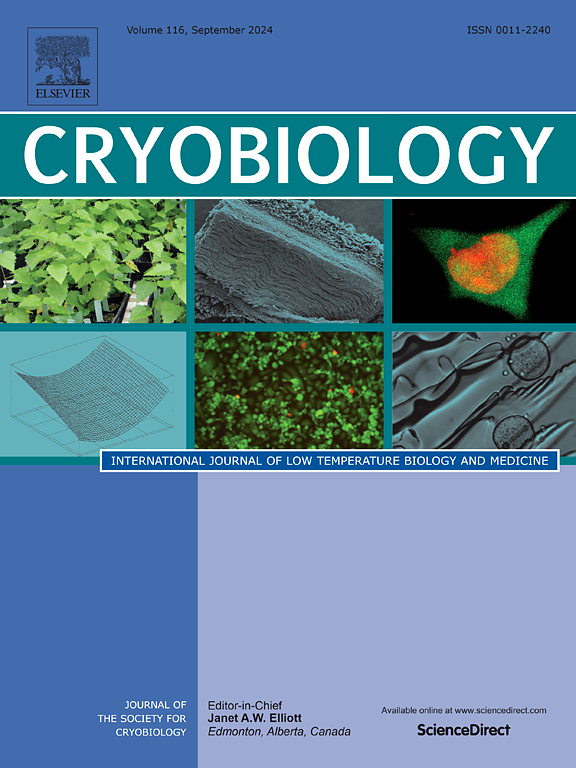不同协议长度和加载策略对完整猪股髁玻璃化的影响。
IF 2.1
3区 生物学
Q2 BIOLOGY
引用次数: 0
摘要
低温保存同种异体关节软骨(AC)移植物是解决新鲜同种异体骨软骨移植治疗大面积关节软骨缺损的潜在候选材料。该技术需要优化,以解决与实际冷冻保存过程相关的问题,并将该技术转化为组织库。在本研究中,我们比较了由多种冷冻保护剂(CPA)加载时间和加载策略组成的不同玻璃化方案,以实现猪完整股骨髁的成功玻璃化-复温方案。猪股内侧髁(n = 6)被用来测试不同时间长度和CPA加载方法的5种玻璃化方法。这些方案对升温后正常的软骨细胞活力、代谢活性和组织开裂频率的影响被记录下来。我们证明,所有5种CPA加载-玻璃化方法都能在猪完整股骨髁玻璃化后产生高正常化的软骨细胞活力(>为新鲜对照的88%)。此外,室温凝胶(RG)方案显示升温后软骨细胞的活力和代谢活性高,并且玻璃化完整股骨髁再升温后AC开裂频率降低。为了便于将该技术转化为组织库,我们表明,通过缩短(方案RG中总时间为15分钟)或将我们建立的方案8(430分钟)与水凝胶结合,包括使用液氮蒸汽冷冻袋作为组织库中的常规储存方法,我们可以引入两种可重复的方案,用于涉及玻璃化骨软骨组织的临床应用。本文章由计算机程序翻译,如有差异,请以英文原文为准。
Vitrification of porcine intact femoral condyle through different protocol lengths and loading strategies
Cryopreservation of articular cartilage (AC) allografts is a potential candidate to solve the shortage of fresh osteochondral allografts to treat large AC defects. This technique requires optimization to address issues related to the actual process of cryopreservation and the translation of the technology to tissue banks. In the present study, we compared different vitrification protocols consisting of multiple cryoprotective agent (CPA) loading timings and loading strategies to achieve successful vitrification-rewarming protocols for porcine intact femoral condyles. Porcine medial femoral condyles (n = 6) were used to test 5 vitrification protocols differing in lengths of time and the method of CPA loading. The effects of these protocols on post-warming normalized chondrocyte viability, metabolic activity, and tissue cracking frequency were documented. We demonstrated that all 5 CPA loading-vitrification protocols resulted in high normalized chondrocyte viability (>88 % of Fresh control) post vitrification in porcine intact femoral condyles. Moreover, the Room Temperature Gel (RG) protocol showed high viability and metabolic activity of chondrocytes post-warming, and also decreased cracking frequency in AC after rewarming of vitrified intact femoral condyles. To facilitate translation of this technology to tissue banks, we showed that by shortening (total time of 15 min in Protocol RG) or combining our established Protocol 8 (430 min) with a hydrogel, including use of cryobags in liquid nitrogen vapour as the conventional storage method in tissue banks, we could introduce two reproducible protocols for clinical applications involving vitrified osteochondral tissue.
求助全文
通过发布文献求助,成功后即可免费获取论文全文。
去求助
来源期刊

Cryobiology
生物-生理学
CiteScore
5.40
自引率
7.40%
发文量
71
审稿时长
56 days
期刊介绍:
Cryobiology: International Journal of Low Temperature Biology and Medicine publishes research articles on all aspects of low temperature biology and medicine.
Research Areas include:
• Cryoprotective additives and their pharmacological actions
• Cryosurgery
• Freeze-drying
• Freezing
• Frost hardiness in plants
• Hibernation
• Hypothermia
• Medical applications of reduced temperature
• Perfusion of organs
• All pertinent methodologies
Cryobiology is the official journal of the Society for Cryobiology.
 求助内容:
求助内容: 应助结果提醒方式:
应助结果提醒方式:


